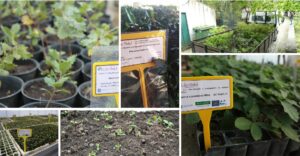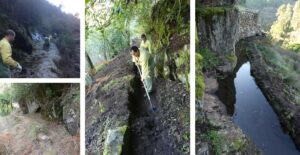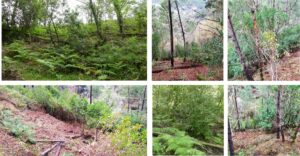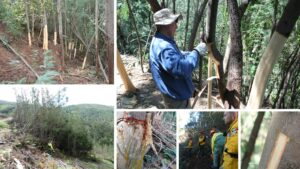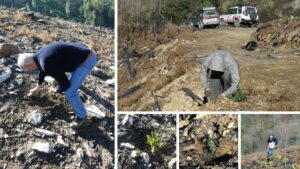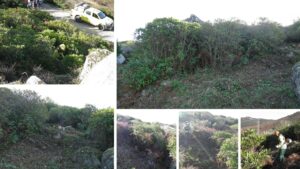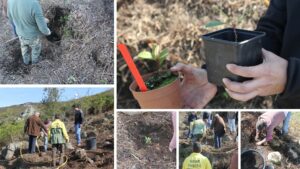Collection and Propagation of Vegetative Material (Action C1)
Throughout the project, around 97 thousand seeds were collected within the project’s intervention areas. The partner CICYTEX carried out several germination trials of shrub species, with the strawberry tree and laurustinus being the most successful, as well as oak species. The Rhododendron was the species with the greatest challenges, as the optimal germination conditions (substrate, temperature, and photoperiod) were not known, nor was there any bibliography. After overcoming these constraints, the rhododendron germination percentage reached 70%. At the end of the project, around 65 thousand plants were delivered to the partners’ nurseries, in Monchique and Seia, to be used in conservation actions, thus, improve and increase the habitat. As a complement, two multiplication manuals were produced, one dedicated to oak species (Quercus L.) and another on species associated with Laurissilva forests, both in Portuguese and Spanish. These manuals are available free of charge on the project website.
Improvement and increase of Portuguese Laurel in the Centre-North (Action C2, C4, C6 & C7)
The Portuguese Laurel groves are forest formations dominated by the Portuguese Laurel (Prunus lusitanica), which is one of the relict species of Laurissilva from the past. It has a scattered distribution, but limited to the Iberian Peninsula, Northern Morocco, and the French Pyrenees. It is considered Endangered by the IUCN (International Union for Conservation of Nature). More than half of the entire Iberian Portuguese Laurel population is concentrated in areas of rugged relief in the mountains of the central interior of Portugal. In the municipality of Seia, the territory belonging to the valleys of the Alvoco and Loriga rivers, tributaries of the Alva River is without a doubt one of the main areas of refuge for this unique tree of Portuguese flora. Not forgetting the iconic Mata da Margaraça in Açor Mountain. However, the landscape of these mountains is also marked by pine and eucalyptus production forests, areas invaded by invasive alien plants, and covered by forest fires that recurrently devastate the center and north of Portugal. In view of these identified threats, the project team implemented several concrete conservation actions in the intervention areas in Cabeça and Casal do Rei (Estrela Mountain) and Mata da Margarça (Açor Mountain).
Within the intervention area of Cabeça, in Seia, there is an old “Levada” that was once deactivated. These “Levadas” are of ancient and rudimentary construction and used to be for irrigate agricultural fields but also to feed some groves of Portuguese Laurel. Therefore, 1.2 km of “Levada” were restored with the aim of recovering the feed flows of these groves.
To improve the conservation status of the Portuguese Laurel habitat sub-type, their floristic structure was enhanced through the removal of species that don’t belong to the system (selective control of heliophilous vegetation) and through the promotion of characteristic species (eliminating competition and targeted planting). That is, heliophilous vegetation are plants typical of non-forest habitats and they like light. However, they don’t belong to the floristic composition of the Portuguese Laurel community, and they promote forest fires in territories with a Mediterranean climate. Thus, the selective control of heliophilous vegetation implemented by the project, not only reduced the risk of fire in all intervention areas but also eliminated the competition and created space for the new planting and development of characteristic species of the Portuguese Laurel. Additional vegetation control of non-invasive exotic species was carried out such as pine trees, to recover areas with ecological potential of the Portuguese Laurel and thus increase its area of occurrence in the medium-long term. However, this control was carried out surgically and only in places where the necessary work did not affect the structure of the habitat.
After managing the vegetation cover, whether heliophilous or exotic, it was possible to plant characteristic species of the Portuguese Laurel, using plants produced by the partner CICYTEX. In some of the intervention areas, such as in the municipality of Seia, the presence of two species with great invasive power was verified: Acacia dealbata and Hakea sericea. Given the threat that these nuclei pose to the preservation of the Portuguese Laurel, control of these species was also carried out.
Special attention was given to adjacent areas of the Portuguese Laurel with the aim of reducing not only the risk of fire but also the speed of the spread of forest fires. Therefore, measures were implemented to encourage the compartmentalization of the landscape and the creation of buffer areas. Thus, it was recovered 3km of access roads within the intervention areas, selective control of vegetation (heliophilous and exotic) and plantations of characteristic species of native oak forests were also carried out.
Improvement and increase of Rhododendron in the South (Action C3, C5 & C7)
The Rhododendrons are tall thickets dominated by the Rhododendron (Rhododendron ponticum subp. baeticum), one of the best examples of relic species from the Tertiary that still survive in the Iberian Peninsula. Once upon a time, Rhododendrons had a greater and continuous distribution in the south of the European continent. Today, they are restricted to only three locations on the Iberian Peninsula: two in Portugal (one in the North, in the Caramulo mountains, and another in the South, mainly in the Monchique mountains); and one in Spain (Aljibe mountains, near Gibraltar). It is these mountainous areas, with relatively hot and humid climates, high oceanic influence, without frost, but with frequent fogs, that provide favorable conditions for the persistence of the Rhododendron. It can occur spontaneously in two distinct ecological positions: on the banks of watercourses (riparian position); and on the edges or undercover of Quercus canarienses forests. The isolation and small size of the Rhododendron populations represent, in themselves, a threat to their preservation making them especially vulnerable to other common threats that affect European biodiversity, such as fire, changes in land use, climate change and invasive alien species. Faced with these identified threats, the project team implemented several concrete conservation actions
in the intervention areas of Foia (Monchique mountains).
Similar to the Portuguese Laurel conservation actions, the Rhododendron habitat sub-type was also targeted for improvement of the floristic structure through the removal of species that do not belong to the system (selective control of heliophilous vegetation) and through the promotion of characteristic species (eliminating competition and making targeted plantations), both in areas of improvement of the habitat structure and also in areas of increment (areas where the target habitat was promoted, as they are potential areas of natural occurrence).
After managing the vegetation cover, plantations were carried out with plants produced by the partner CICITEX. To reduce the risk of fire and promote the slowing down of the fires speed in adjacent areas to the Rhododendron habitat, measures were implemented for the creation of the landscaper compartmentalization and buffer areas creation. More specifically, it was done selective control of vegetation, not only heliophilous but also invasive such as eucalyptus, recovery of existing hardwood areas and plantation of characteristics species of native oak forests, including the Monchique oak (Quercus canariensis), which is a critically endangered tree in Portugal.
For more information about other actions, please click on the following images:



